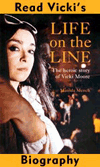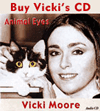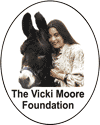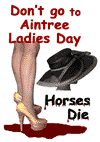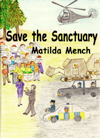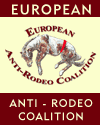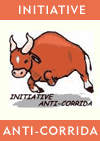RODEO
The Myth
A great many people, especially those in Europe, do not really know what a rodeo involves.
At first sight it might seem like a bit of harmless fun. After all, most of the animals are wild and untamed, while the cowboys are just showing off the skills of the 'Old Wild West', aren't they? And anyway the animals are tough and suffer no real harm?
The TruthIn fact the animals are ordinary, domesticated farm animals made to appear 'wild' by a number of painful tricks. Most of the disciplines, for example Bull Riding and Ribbon Roping etc, were never used by the traditional cowboy. The disciplines displayed in a rodeo become totally different, when competing against the clock, to what would have happened on working ranches, where the health of the animal was of a greater importance. |
Animals Used In Rodeo
Cattle and horses are used in European rodeo. In the USA pigs and sheep are also used.
The Treadmill For The AnimalsThe same animals are used again and again in rodeos, they have to perform several times in one rodeo. Afterwards they are loaded up and transported to the next event. Frequent transporting is stressful. The animals live in small pens for days on end (left), before, during and after the rodeo. |
Animal Injuries
As a result of the abuse to the animals, many injuries occur. Broken bones, contusions, concussions, skin-abrasions and internal bleeding are quite common. Some injuries can result in an animal's death. Some disciplines can cause broken neck and spine.
The Disciplines
| Bareback Riding: Horses are ridden without a saddle The rider has to stay on for 8 seconds. |
Saddled Bronc Riding: Horses are ridden with a saddle. The rider has to stay on for 8 seconds. |
| Horse Tripping: A Mexican specialty, horses are thrown to the ground. |
Bull Riding: Bulls are ridden for 8 seconds. |
| Wild Horse Race: A team of three men tries to break a horse, one has to be on the horse in the end. |
Steer Wrestling: A steer is wrestled to the ground. |
| Calf Roping: A calf is roped from horseback and thrown to the ground. |
Breakaway Roping: A calf is roped from horseback, the rope falls from the saddle. |
| Team Roping: A calf is roped by two riders and thrown to the ground. |
Steer Tripping: Larger calves are thrown to the ground and dragged through the sand. |
| Ribbon Roping: A young bull is caught with a rope; a ribbon has to be taken off his horns. |
Barrel Racing: Horses race around barrels at high speed. |
| Pole Bending: Horses race around poles at high speed. |
Mutton Bustin: Sheep are ridden by young children. |
| Wild Cow Milking: Teams of men chase a herd of non-dairy cows around the arena, forcibly hold and try to milk them. |
Wild Boar Chasing: Pigs or piglets are greased and chased through the ring by children. |
The Flank Strap - One of the tricks that make the animals buck
This is a strap, put around the lower abdomen and pulled tight when the horse or bull leaves the chute. The strap puts a lot of pressure on this very sensitive area on a horse's body and he has no alternative but to buck as a reflex action. On occasions they are so stressed with this that they rear up and collapse even before leaving the chute. As soon as the flank strap is taken off, the animal stop bucking.
In the case of the bulls the flank strap puts pressure on the uretha.
Other Tricks
Spurs are also used to make the animals appear wild.
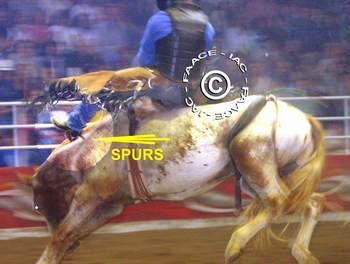
The use of electric shocking devices is forbidden in Germany, but is quite common around the world.
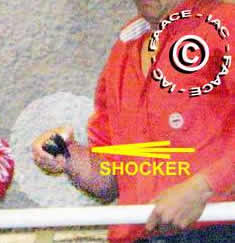
Countries Where Rodeo Takes Place
Rodeos are carried out in the USA, Canada, Latin America (foremost Brazil), Australia and New Zealand, Asia (Philippines) and Europe (Portugal, Germany, Hungary, Poland, Czech Republic, France and Italy).
Rodeo Video
To get some idea of a rodeo in action watch this film that FAACE shot in 2009 of a PRCA rodeo taking place in a bullring in Valencia, Spain. The PRCA (Professional Rodeo Cowboy Association) is the most important organiser of rodeos in the USA.
Rodeo In Germany
Rodeo is a legacy of the US Army's time in Germany. At first it only took place in or around US Army bases. It is still legal in Germany, because the term "rodeo" is not clearly defined in the animal protection law. It only requires a state veterinary officer has to make the decisionwhether to allow a rodeo to take place in his area. Rodeos in Germany take place during German-American Festivities and in so-called Western Towns; and also on private property.
Good News For Germany
In 2004 the "Wild Boar Chase" and "Wild Cow Milking" were banned nationwide. An expert opinion by German vets has led to the "Wild Horse Race", "Bull Riding", spurs and flankstrap being banned in most German federal states in 2006. The two remaining states will follow. Read it here.
Nico Rosberg - Machismo Gone Wrong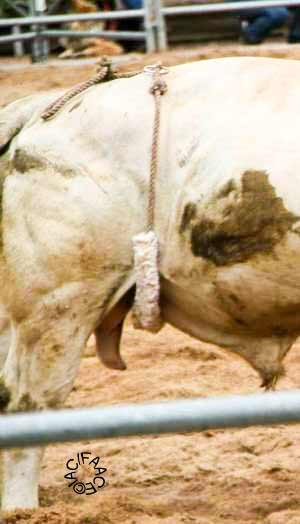
In his Xmas video, which is all over the internet, Formula 1 driver Nico Rosberg rode a rodeo bull.
The brutal flank strap which causes painful pressure on the uretha is clearly visible (see image).
An act of bravado for him, a promotion of cruelty for the animals. He should stick to cars that don't feel pain. Please let him and his team know your thoughts on rodeo cruelty.
* E-mails: management@nicorosberg.com , press@nicorosberg.com ,enquiries@mercedes-gp.com
What Can You Do?
Don't go to a rodeo event. Don't support rodeo by your entrance fee. Ask your friends and family to stay away from rodeo.
Inform us, if you know about a rodeo with animals that happens in your area of Europe.
Protest to your local and national governments.
Write letters to the editor, when you find an article that advertises rodeo.
Please inform us, if you come across a travel agent who advertises trips to a rodeo.
Please protest against Italy's cruel rodeo events.
FAACE is a member of the European Anti-Rodeo Coalition (EARC)


